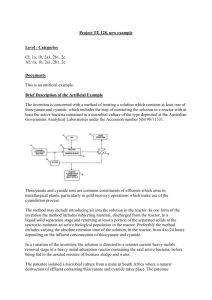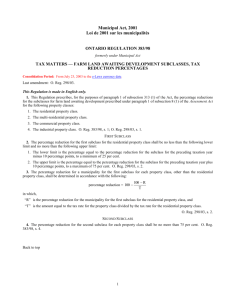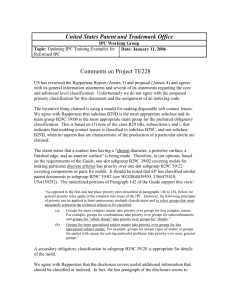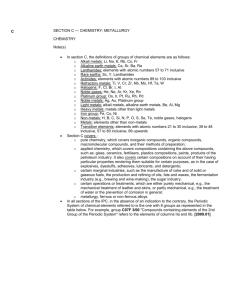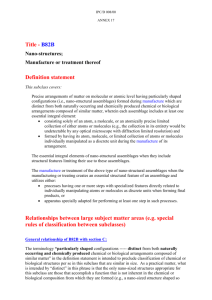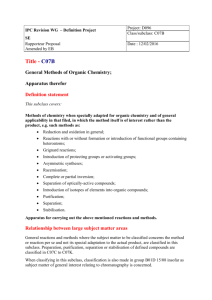10 - WIPO
advertisement
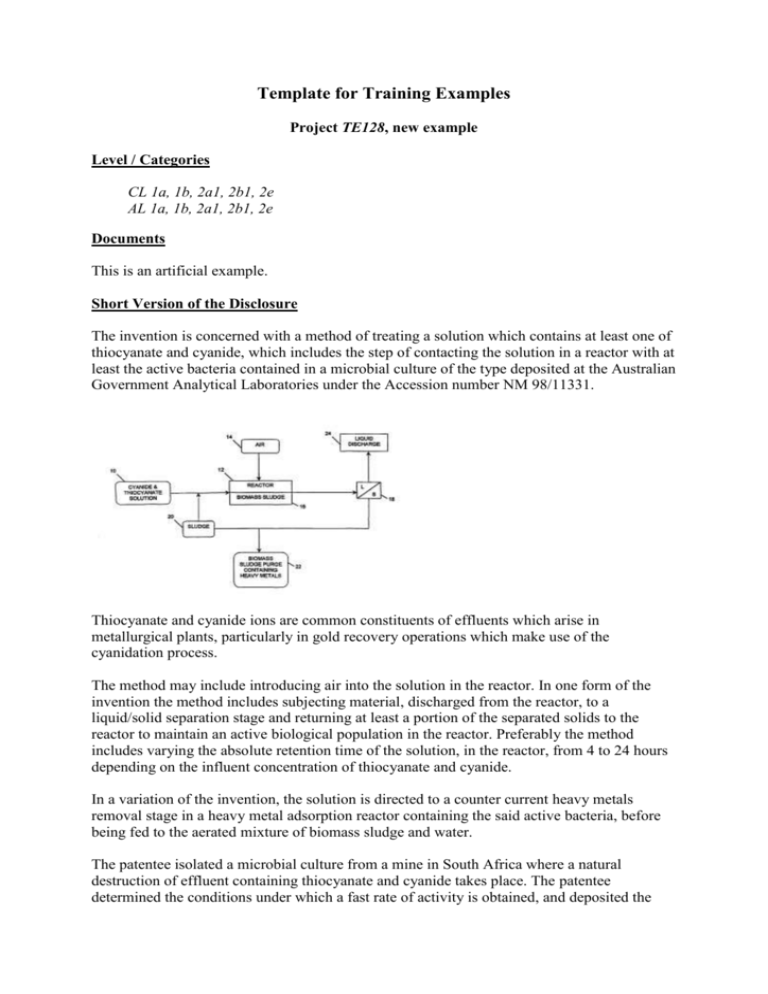
Template for Training Examples Project TE128, new example Level / Categories CL 1a, 1b, 2a1, 2b1, 2e AL 1a, 1b, 2a1, 2b1, 2e Documents This is an artificial example. Short Version of the Disclosure The invention is concerned with a method of treating a solution which contains at least one of thiocyanate and cyanide, which includes the step of contacting the solution in a reactor with at least the active bacteria contained in a microbial culture of the type deposited at the Australian Government Analytical Laboratories under the Accession number NM 98/11331. Thiocyanate and cyanide ions are common constituents of effluents which arise in metallurgical plants, particularly in gold recovery operations which make use of the cyanidation process. The method may include introducing air into the solution in the reactor. In one form of the invention the method includes subjecting material, discharged from the reactor, to a liquid/solid separation stage and returning at least a portion of the separated solids to the reactor to maintain an active biological population in the reactor. Preferably the method includes varying the absolute retention time of the solution, in the reactor, from 4 to 24 hours depending on the influent concentration of thiocyanate and cyanide. In a variation of the invention, the solution is directed to a counter current heavy metals removal stage in a heavy metal adsorption reactor containing the said active bacteria, before being fed to the aerated mixture of biomass sludge and water. The patentee isolated a microbial culture from a mine in South Africa where a natural destruction of effluent containing thiocyanate and cyanide takes place. The patentee determined the conditions under which a fast rate of activity is obtained, and deposited the microbial culture at the Australian Government Analytical Laboratories under the Accession number NM98/11331. If the solution contains heavy metals such as copper, gold, arsenic and nickel which are to be removed, e. g. for commercial or environmental reasons, then a modified process of the invention may be employed, whereby an aqueous thiocyanate and cyanide solution is fed to a counter current metal adsorption reactor. Heavy metals and cyano-metal complexes are removed from the solution by adsorption onto the biomass. The biomass sludge from this reactor is not agitated. This allows the biomass sludge to settle in the reactor, thus automatically giving rise to a liquid/solid separation step. The separated biomass sludge containing heavy metals is purged and thereafter treated in any appropriate way to recover the heavy metals. The thiocyanate and cyanide are degraded to relatively harmless inorganic compounds of carbonate or carbon dioxide, sulfate and ammonium, and carbonate or carbon dioxide and ammonium respectively. Invention Information I1: A method for treating an effluent solution containing thiocyanate and/or cyanide, by contacting the solution with at least the active bacteria contained in a microbial culture of the type deposited in the above laboratory in Australia. Additional Information A1: In addition to removal of thiocyanate and/or cyanide, heavy metal removal is mentioned as a variation of the invention, including removal of copper, gold, arsenic and nickel (this is inapplicable to the core level since the indexing schemes in C02F are not in the core level). When this heavy metal removal is for commercial reasons, this equates to production of these metals. A2: The origins of the effluent are mentioned as metallurgical plants, especially for gold recovery (this is inapplicable to the core level since the indexing schemes in C02F are not in the core level). Identification of Potential Subclasses Subject Matter Tool Query IPC Places I1, A1, A2 Catchword Index Treatment of WASTE water C02F I1, A1 Catchword index Production or refining of METALS or alloys in general C22 I1 TACSY “harmful chemicals” A62D Analysis and Selection of Classification Symbols Core Level I1: (a) Treatment of water, waste water, sewage, sludge or any other aqueous effluent is covered by function-oriented subclass C02F, which is subject to the common rule. Biological treatment of waste water is in main group C02F 3/00, and treatment characterized by the micro-organisms used is covered by group C02F 3/34. This is the group that most adequately represents the invention and is therefore listed first. The process can also be regarded as an activated sludge process and should therefore be classified in C02F 3/12. (b) Note (1) after the subclass title of C02F makes it clear that processes using microorganisms classified in C02F are not further classified in subclass C12S. Moreover a similar reference in the subclass title of C12S makes it clear that biological treatment of water, waste water and sewage is classified in C02F 3/00. It is therefore clear from these notes and references that no classification should be made in subclass C12S. (c ) Despite there being no adequate Catchword Index entry here, it appears that subclass A62D is relevant. This group covers making harmful chemical substances harmless or less harmful by effecting a chemical change in these substances. Since the thiocyanate and cyanide are degraded to relatively harmless inorganic compounds of carbonate or carbon dioxide, sulfate and ammonium, and carbonate or carbon dioxide and ammonium respectively, A62D 3/00 seems relevant. A1, A2: (a) Production of heavy metals is mentioned in note (1) under the subclass title of C02F; this states that production of metallic elements themselves is in C22B. The relevant term here for liquid/solid separation is C22B 3/00. (b) The indexing schemes of C02F 101/00 to 103/44 are not in the core level. The nature of the contaminant and the origins of the effluent cannot be recorded in the core level. Advanced Level I1: (a) Treatment of water, waste water, sewage or sludge is covered by function-oriented subclass C02F, which is subject to the common rule. Biological treatment of waste water is in main group C02F 3/00, and treatment characterized by the micro-organisms used is covered by group C02F 3/34. This is the group that most adequately represents the invention and is therefore listed first. The process can also be regarded as an activated sludge process and should therefore be classified in C02F 3/12. (b) Note (1) after the subclass title of C02F makes it clear that processes using microorganisms classified in C02F are not further classified in subclass C12S. Moreover a similar reference in the subclass title of C12S makes it clear that biological treatment of water, waste water and sewage is classified in C02F 3/00. It is therefore clear from these notes and references that no classification should be made in subclass C12S. (c ) Despite there being no adequate Catchword Index entry here, it appears that subclass A62D is relevant. This group covers making harmful chemical substances harmless or less harmful by effecting a chemical change in these substances. Since the thiocyanate and cyanide are degraded to relatively harmless inorganic compounds of carbonate or carbon dioxide, sulfate and ammonium, and carbonate or carbon dioxide and ammonium respectively, A62D 3/00 seems relevant. A1: The nature of the contaminant and heavy metal removal are covered by the indexing scheme of C02F 101/00 to 103/44. Thiocyanate is covered by C02F 101/16, cyanide is covered by C02F 101/18, and heavy metals by C02F 101/20. Indexing terms are regarded as additional information. Production of heavy metals is mentioned in note (1) under the subclass title of C02F; this states that production of metallic elements themselves is in C22B. The relevant term here for liquid/solid separation is C22B 3/24. A2: The origins of the effluent (metallurgical plants, especially for gold recovery) are covered by indexing term C02F 103/16. IPC CL Subject Matter Analysis of Subclass Selection Subclass I1 Subclass title covers subject matter; Note (1) after C02F subclass title. C02F Common rule C02F 3/34, 3/12 C02F 3/34, 3/12 I1 Subclass title covers subject matter A62D Common rule A62D 3/00 A62D 3/00 A1 Subclass title covers subject matter C02F Indexing terms None C02F 101/16, 101/18, 101/20 A1 Note (1) under C02F C22B Common rule C22B 3/00 C22B 3/24 (2006.01) A2 Subclass title covers subject matter C02F Indexing terms None C02F 103/16 Analysis of Group Selection IPC AL IPC(2006) Complete Classification The complete core and advanced level classification for this document based on the above analysis is as follows: Core level Int. Cl. (2006) C02F 3/34 C02F 3/12 A62D 3/00 C22B 3/00 Advanced level Int. Cl. C02F 3/34 (2006.01) C02F 3/12 (2006.01) A62D 3/00 (2006.01) C02F 101/16 (2006.01) C02F 101/18 (2006.01) C02F 101/20 (2006.01) C02F 103/16 (2006.01) C22B 3/24 (2006.01)
